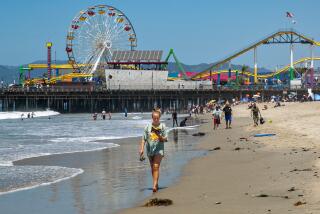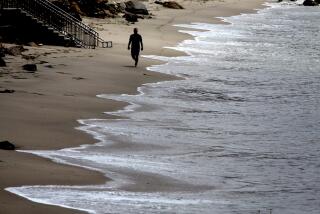Tracking an Unseen Scourge
- Share via
Picturesque yachts cruising sapphire waters may symbolize Orange County’s affluence, but some of the 16,000 boaters docked here are also secretly spoiling its coastal treasures.
Under cover of darkness and the turning tide, some boaters illegally flush waste into the protected waters of the county’s harbors.
“It’s something that, over the years, we’ve always suspected was a source of contamination in [Newport Bay],” said Kurt Berchtold, assistant executive officer with the Santa Ana Regional Water Quality Control Board. “This is something we’ve been concerned about for 20 years.”
Officials don’t know the extent of the dumping and its effects. They hope that most boaters obey the law and either dump their waste tanks three miles out to sea or use a pumping station in a harbor.
But it’s an honor system, and the potential for environmental damage from those who flout the law is enormous. One weekend boater’s discharge contains the same amount of bacteria as does the treated sewage of 10,000 people. The waste not only kills fish and harms other marine life but is dangerous to humans.
To try to get a handle on the problem, Newport Beach and the Southern California Coastal Water Research Project will begin trying within a few weeks to determine how much boaters are contributing to high fecal coliform counts in the bay, as part of a longer study about bay pollution.
Parts of Newport Bay have been off-limits to swimming since 1974.
Concerns about boat waste prompted Los Angeles County’s health department to threaten to close Avalon Harbor on Catalina Island to recreational water contact in 1988. Local officials responded by enacting one of the toughest enforcement measures in the nation. Boats are only allowed to enter Avalon Harbor if the owners allow dye tablets to be placed in the heads.
If released, the dye “turns lime green--it’s very visible,” said harbor master Brian Bray.
Violators who dump waste in the harbor are banned for a year. Since the regulation was implemented in August 1988, 371 boaters have been caught illegally dumping, and bacteria levels have dropped significantly, Bray said.
Such a solution might not be feasible in Orange County harbors because of the number of boats, the shape of the harbors and the water’s natural turbidity.
However, Kiff said it might be part of the upcoming study.
Boaters, of course, are not the only sources of pollution in local harbors. Contamination from wildlife droppings, creeks, flood-control channels and thousands of storm drains all find their way to the sea. Stretches of Newport and Dana Point harbors have long-term postings warning of health hazards because of chronic pollution. Data released Tuesday from the first phase of the Newport Bay study showed enterovirus, a human virus that causes gastrointestinal problems, entering the waters from the Santa Ana-Delhi Channel.
Health hazards from boat dumping are particularly worrisome, however, because humans are more likely to get sick from disease carried in human waste than in animal waste.
“The risk factor is much higher,” said Monica Mazur, spokeswoman for the county Health Care Agency. “The harbors are very close to where people are using the beaches. You have small children out there.”
Officials and activists say that the vast majority of boaters properly discharge their waste. Capt. Marty Kasules, Orange County’s harbor master, said he and the sheriff’s deputies who look for illegal dischargers only investigate four or five people annually who might be contributing.
However, officials concede it’s incredibly difficult to catch illicit dischargers. And there are only 47 sheriff’s deputies and supervisors to cover the thousands of boats in all three harbors.
Boat waste was known to be a significant problem two decades ago. A 1984 study found bacterial levels higher on weekends than during the rest of the week, “strongly suggesting that discharges from boats are a source of this contamination,” according to the Santa Ana Regional Water Quality Control Board.
“Asked in 1984, I was convinced that boats played a major factor,” said Dr. Jack Skinner, a respected local physician and co-founder of Stop Polluting Our Newport. Now, “the question that is unanswered is are boaters [still] causing any of the problem?”
The number of pump-out stations have increased, and they’re more likely to function. Since the 1992 federal Clean Vessel Act identified vessel sewage discharges as “a substantial contributor to localized degradation of water quality in the United States,” more than $2 million has been distributed in California to partially fund about 150 such stations, said Megan Standard, spokeswoman for the California Department of Boating and Waterways.
Still, environmentalists remain wary.
Bob Caustin is founder of Defend the Bay, the group that successfully sued the EPA to get tougher pollution standards for Newport Bay.
He says the key to enforcement is dye tablets for vessels such as houseboats, which sometimes never leave their moorings, and requiring written records that show when a pump-out station is used or when a boat leaves the harbor.
With the existing enforcement, “they’re just putting their heads in the sand,” he said.
(BEGIN TEXT OF INFOBOX / INFOGRAPHIC)
Where to Pump
Discharging raw or treated sewage into Orange County’s harbors is illegal. While most boaters either release it three miles offshore or into a pump-out station in a harbor, a small number ignore state and federal law, contributing to local pollution.
DISCHARGE RULES
* Never discharge raw sewage into California waters
* Never discharge treated or raw sewage into protected waters, shallow coves, near shellfish beds or swimming beaches.
* Choose disinfectants for a marine sanitation device that do not contain chorine, ammonia or formaldehyde, which are harmful to aquatic life.
* If a boat is in state waters--within the three-mile limit--the Y valve for overboard discharge must be secured, preferably with a padlock or non-releasable wire tie.
Source: California Department of Boating and Waterways
More to Read
Sign up for Essential California
The most important California stories and recommendations in your inbox every morning.
You may occasionally receive promotional content from the Los Angeles Times.














